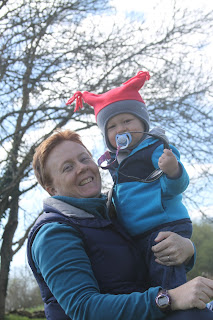After a lovely time with Marie-Therese and Jean-Claude in La Baule, we headed west into deep Brittany. We stayed in the lovely old town of Quimper and took several day trips around the region.
There is a really nice aquarium in Brest, and we went to see what it had to offer. It was very well done, and we enjoyed ourselves!
Ian almost got eaten by a shark!
On another day, we headed to the Crozon Peninsula and visited the Pointe de Pen-Hir. The rugged coast suggests that the sea is not always so calm!
Behind the gorse hedge you can see sailboats in front of the jagged rock islands.
Bertie was delighted with the damp field of grass and explored the linked sciences of running amok and banging rocks together.
For lunch we visited Camaret-sur-Mer, just north of the Pointe de Pen-Hir. In summer, this would be hopping with tourists, but in early April we had the place more or less to ourselves.
Another tiny ancient street, this one with the traditional Breton blue.
Across the harbor from the main town we found a seafarers' church with dates in the mid-1600s. Most Breton churches have boat-shaped roofs to tie them closely to the sailors' lives that supported them. This church, obviously partly redone to highlight the maritime theme, did not disappoint on the inside.
Ships hang from the ceiling down the nave, and you can see that the shape of the roof is like an upside down hull of an old-fashioned ship.
Close-up of the altar.
More cool stained glass.
We even saw a friendly baby dragon!
------
Carnac
Carnac is a prehistoric site of thousands (literally) of standing monoliths in straight lines that stretch for hundreds of meters in a variety of formations. The monoliths (menhirs) date from around 4500 BCE and draw lots of tourists. This sign features both French (Carnac) and Breton (Karnag). Breton national identity is growing stronger.
Some of the standing stones. It is impossible to get a sense of the scale and scope without an aerial view, but we took photos from as many angles as we could. Non-menhir activities have crept into the area of the stones over the past 4 millennia, and Bretons live comfortably with their prehistory.
Bertie liked Carnac a lot. It was one of the first non-frigid days we had, and he got to ride Ian's shoulders almost all day!
Happy boys!
Sailboats in the Golfe de Morbihan.
--------------
Mont St Michel
Heading back east from Quimper, we visited Mont St Michel. It is a giant rock on the north coast of France that has been home to a church since around 800 CE. Because churches were protectors, the town of Mont St Michel has grown up with the church. It is an architectural wonder and a delightful place to visit.
We climbed to the cathedral via the wall on the land side of the island because the streets were packed. As you move across the island/ town, you get very different views of the cathedral and the town.
Narrow streets with old houses leaning in. There are several alleys with stairs that broad-shouldered people would struggle to pass through.
The town roofs as seen from the wall.
Mama can carry the backpack too!
Looking back across the Bay of Mont St Michel. Like other parts of western France, the tide comes in fast. Mont St Michel sits on the Norman side of the Brittany-Normandy border (a source of much inter-provincial angst). The river that marks the boundary has shifted in its course over the past centuries placing Mont St Michel in Normandy.
A view of the abbey from the cloisters.
Inside the abbey; pale stained glass makes for light and airy cathedrals!
But there's still beauty in richly colored stained glass....
Ian and Bertie met a short knight on the way back down.
One final shot of crowded, tourist-jammed streets (admittedly the crowds were thinned at the end of the day).
-------
St Malo
We headed back into Brittany for our last few nights and stayed in St Malo, a traditional seaside watering hole that was almost completely destroyed by Allied bombing during WWII and then almost completely restored in its original appearance during reconstruction. St Malo is surrounded by a high wall with a broad walking surface. It is a great place to see the English Channel and its many colors.
Looking into town from the wall. Although St Malo is historical and lovely, it looks like it could be very dark a lot of the time.
The Channel.
The tides are dangerous in St Malo as well, although they appear to pose a more active threat here than in other places...
Finally we found something Bertie could understand and concentrate on!












































No comments:
Post a Comment